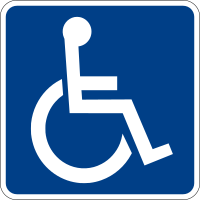Culture is Frozen Struggle.
-after Roberto Unger
In our fight against ableism/disableism, we have passed through a legislative age (peaking with the passage of the ADA), and we are now in an operational age, in which building support systems and creating communities that are accessible are the focus, whether through policy change, legislation, or community organizing.
What might the future hold?
- Collaboration with other communities for change that includes our issues, in a broader context of struggle
We remain isolated from the community of psychiatric survivors and that of people with developmental and cognitive disabilities. The joke still is, “I may be _____, but I’m not ______!” (replace with your favorite vulnerable and oppressed communities). There is still no usable consensus on how to make the web accessible to people with low literacy, and the web as a whole is still growing faster than the accessible web. Driving change through peer relationships and peer organizations is still at its very beginning in both of these communities.
But Michigan has 500 peers working in the mental health system, a group of adults with DD is developing a model of peers, and I saw a nice article about an anarchist conference where safe spaces for recovery was a break out session.
- The oppression of people with disabilities still remains a cultural and ethical “right”.
While there is a lot more going on internationally than even a couple of years ago, people with psychiatric labels and persons with developmental disabilities still wallow in hideous institutions, not to mention nursing homes, both here and everywhere.
Medicine is finding (even developing standards for), killing us before we would die on our own, not treating us, and consigning us to ethical limbos based on our “inferiority”. Sterilization of people with DD still goes on in hospitals everywhere. Stephen Drake and Not Dead Yet still have way too much to do.
But, institutions are being challenged internationally, families are finding the courage to challenge their members oppression, and multi-ethnic culturally focused collaborations are fighting against the assumption of cultural “rights” to oppress.
I think these two arenas are the grounds upon which our struggles will take place for the next generation.
And we need to start working on prisons and disability and post-incarceration peer support.
Struggles they will be…….
Technorati Tags:
disableism day
![Reblog this post [with Zemanta]](http://img.zemanta.com/reblog_e.png?x-id=7fd1caa7-c72c-4d11-b400-f001f2ac91d5)
![Reblog this post [with Zemanta]](http://img.zemanta.com/reblog_e.png?x-id=651b9963-98f4-4b3c-9b82-1043ef459ec4)



![Reblog this post [with Zemanta]](http://img.zemanta.com/reblog_e.png?x-id=85813f69-35b7-434a-b32c-d49487fd4896)

![Reblog this post [with Zemanta]](http://img.zemanta.com/reblog_e.png?x-id=d7fa189d-e00f-49e6-a22d-41789b929ef6)
![Reblog this post [with Zemanta]](http://img.zemanta.com/reblog_e.png?x-id=53fcc207-2ad6-4eed-aa6f-299c1ea1c26c)
![Reblog this post [with Zemanta]](http://img.zemanta.com/reblog_e.png?x-id=d946aa7d-fce6-4ab6-b4cd-ad8e5217366b)

![Reblog this post [with Zemanta]](http://img.zemanta.com/reblog_e.png?x-id=ec4fb7de-2188-4a88-a13e-e9985d6df74e)

![Reblog this post [with Zemanta]](http://img.zemanta.com/reblog_e.png?x-id=a4352bac-2bdb-495c-a03b-c97ece6eb4e0)

![Reblog this post [with Zemanta]](http://img.zemanta.com/reblog_e.png?x-id=0018a50d-a953-4b56-88d8-d90b323e7595)

![Reblog this post [with Zemanta]](http://img.zemanta.com/reblog_e.png?x-id=1ba29f8f-cb34-437a-b850-9fc9de395f34)
![Reblog this post [with Zemanta]](http://img.zemanta.com/reblog_e.png?x-id=4a69ecf0-65b2-468d-907d-01f25e18a90d)